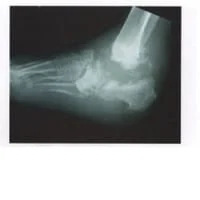Have you recently experienced a traumatic injury to a part of your body? Have you had a compound fracture, use a prosthetic device, or have a diabetic ulcer on your foot? Do you now have an infection in your foot?
Osteomyelitis is a type of bacterial bone infection that moves from acute to chronic phases quickly. The infection usually begins in

With osteomyelitis, the infected bone fills with a pus that deprives the bone of its needed blood supply. Over time, this can result in the death of bone tissue. It is caused by staphylococcus bacteria, a germ that can be found on healthy people. This bacteria can enter through your bloodstream via pneumonia or a urinary tract infection and to the weakened bone. Staphylococcus bacteria can also be transmitted through other infections or wounds in your body and direct contamination via a compound fracture.
Those with osteomyelitis may find that they are experiencing fever and chills, pain in the area of the infection, and swelling, warmth, and redness over the affected area. Sometimes ostemyelitis has no signs or symptoms or has signs or symptoms that can easily be diagnosed as something else.
If you've recently had a compound bone fracture, deep puncture wound or surgery to repair broken bones, you are at risk for osteomyelitis. Those with poorly controlled diabetes, peripheral arterial disease, and sickle cell disease impair good blood flow, and therefore your body has a difficult time fighting infections like ostemyelitis. Individuals who use medical tubing for dialysis machines, urinary catheters, or for long-term intravenous tubing, have an "open gateway" for germs to enter. Conditions and factors that impair the immune system, like chemotherapy, having an organ transplant, or needing to take corticosteroids also put you at risk. Finally, those who take illegal drugs through needles are at risk because the needles are not typically sterilized before use.
Complications from osteomyelitis may include:
- Bone death. Infection in the bone will impede blood circulation to the bone, and cause bone death. Your bone can, however, heal after surgery to remove small sections of dead bone. But, if a large part of your bone has died, amputation may be necessary.
- Septic arthritis. Infection in bones can spread to nearby joints.
- Impaired growth. In children with osteomyelitis, the growth plates are commonly affected. Normal growth can be affected in these areas.
- Skin cancer. In cases where osteomyelitis has turned pussy, the surrounding skin can develop squamous skin cancer.
The presence of bone infection can be diagnosed with tests, such as bone scans, blood tests, X-rays, CT scans, MRIs, and bone biopsies.
Osteomyelitis infections are very difficult to cure with oral or intravenous antibiotics. In chronic cases, surgical removal of the dead bone tissue is usually required. Antibiotics are typically given through a vein in your arm for four to six weeks. Side effects include nausea, diarrhea, and vomiting. Surgery may include one of the following methods:
- Drain the infected area. By opening the area around the infection, your podiatric surgeon can drain any pus or fluid that has accumulated.
- Remove the diseased bone and tissue. The surgeon will debride, or remove, as much of the diseased bone and tissue as possible, taking a small portion of healthy bone to ensure the infection is gone.
- Restore blood flow to the bone. Your surgeon may fill in the empty space from the debridement with a piece of bone or tissue as a temporary filler until you are healthy enough to get a bone or tissue graft.
- Remove foreign objects. If you've had this procedure previously, old plates or screws may have to be removed.
- Amputate the limb. This is a final recourse and will not happen in all cases.
If you are prone to infections, talk to your podiatrist about reducing your risk. Try to avoid cuts and abrasion and clean them right away. Check wounds for signs of infection.
Reference: http://www.mayoclinic.com/health/osteomyelitis/DS00759 .

